
A total solar eclipse will occur at the Moon's ascending node of orbit between Monday, May 21 and Tuesday, May 22, 2096, with a magnitude of 1.0737. A solar eclipse occurs when the Moon passes between Earth and the Sun, thereby totally or partly obscuring the image of the Sun for a viewer on Earth. A total solar eclipse occurs when the Moon's apparent diameter is larger than the Sun's, blocking all direct sunlight, turning day into darkness. Totality occurs in a narrow path across Earth's surface, with the partial solar eclipse visible over a surrounding region thousands of kilometres wide. Occurring about 13 hours after perigee, the Moon's apparent diameter will be larger.

A total solar eclipse occurred at the Moon’s descending node of orbit on Saturday, December 4, 2021, with a magnitude of 1.0367. A total solar eclipse occurs when the Moon's apparent diameter is larger than the Sun's and the apparent path of the Sun and Moon intersect, blocking all direct sunlight and turning daylight into darkness; the Sun appears to be black with a halo around it. Totality occurs in a narrow path across Earth's surface, with the partial solar eclipse visible over a surrounding region thousands of kilometres wide. Occurring about 2.5 hours before perigee, the Moon's apparent diameter was larger.
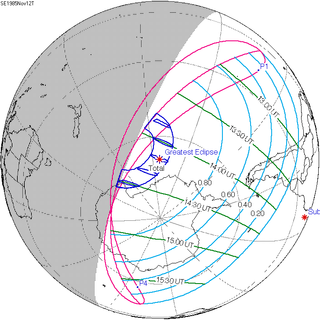
A total solar eclipse occurred at the Moon's descending node of orbit on Tuesday, November 12, 1985, with a magnitude of 1.0388. A solar eclipse occurs when the Moon passes between Earth and the Sun, thereby totally or partly obscuring the image of the Sun for a viewer on Earth. A total solar eclipse occurs when the Moon's apparent diameter is larger than the Sun's, blocking all direct sunlight, turning day into darkness. Totality occurs in a narrow path across Earth's surface, with the partial solar eclipse visible over a surrounding region thousands of kilometres wide. Occurring about 2 hours after perigee, the Moon's apparent diameter was larger. Perigee did occur during the early portion of the eclipse.

A total solar eclipse occurred at the Moon's descending node of orbit between Thursday, November 22 and Friday, November 23, 1984, with a magnitude of 1.0237. A solar eclipse occurs when the Moon passes between Earth and the Sun, thereby totally or partly obscuring the image of the Sun for a viewer on Earth. A total solar eclipse occurs when the Moon's apparent diameter is larger than the Sun's, blocking all direct sunlight, turning day into darkness. Totality occurs in a narrow path across Earth's surface, with the partial solar eclipse visible over a surrounding region thousands of kilometres wide. Occurring about 2.1 days after perigee, the Moon's apparent diameter was larger.
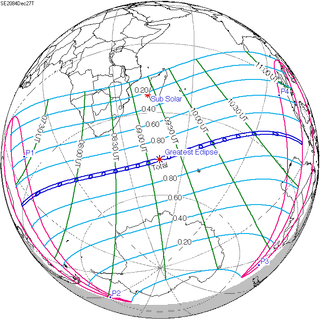
A total solar eclipse will occur at the Moon's ascending node of orbit on Wednesday, December 27, 2084, with a magnitude of 1.0396. A solar eclipse occurs when the Moon passes between Earth and the Sun, thereby totally or partly obscuring the image of the Sun for a viewer on Earth. A total solar eclipse occurs when the Moon's apparent diameter is larger than the Sun's, blocking all direct sunlight, turning day into darkness. Totality occurs in a narrow path across Earth's surface, with the partial solar eclipse visible over a surrounding region thousands of kilometres wide. Occurring only about 21 hours before perigee, the Moon's apparent diameter will be larger.
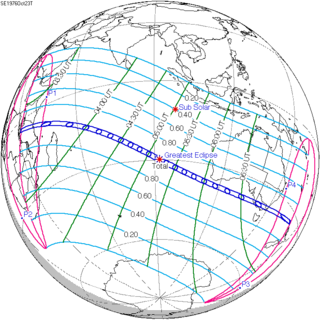
A total solar eclipse occurred at the Moon's ascending node of orbit on Saturday, October 23, 1976, with a magnitude of 1.0572. A solar eclipse occurs when the Moon passes between Earth and the Sun, thereby totally or partly obscuring the image of the Sun for a viewer on Earth. A total solar eclipse occurs when the Moon's apparent diameter is larger than the Sun's, blocking all direct sunlight, turning day into darkness. Totality occurs in a narrow path across Earth's surface, with the partial solar eclipse visible over a surrounding region thousands of kilometres wide. Occurring only about 9 hours before perigee, the Moon's apparent diameter was larger.
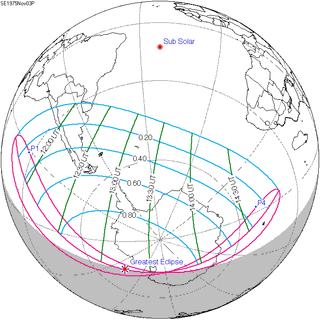
A partial solar eclipse occurred at the Moon's ascending node of orbit on Monday, November 3, 1975, with a magnitude of 0.9588. A solar eclipse occurs when the Moon passes between Earth and the Sun, thereby totally or partly obscuring the image of the Sun for a viewer on Earth. A partial solar eclipse occurs in the polar regions of the Earth when the center of the Moon's shadow misses the Earth.

A total solar eclipse occurred at the Moon's ascending node of orbit on Wednesday, October 23, 1957, with a magnitude of 1.0013. A solar eclipse occurs when the Moon passes between Earth and the Sun, thereby totally or partly obscuring the image of the Sun for a viewer on Earth. A total solar eclipse occurs when the Moon's apparent diameter is larger than the Sun's, blocking all direct sunlight, turning day into darkness. Totality occurs in a narrow path across Earth's surface, with the partial solar eclipse visible over a surrounding region thousands of kilometres wide. Occurring about 1.4 days after perigee, the Moon's apparent diameter was larger.
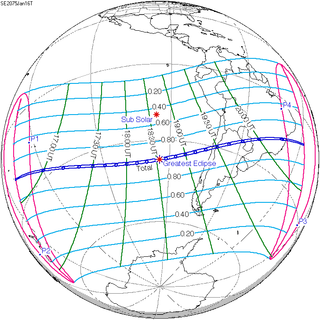
A total solar eclipse will occur at the Moon's descending node of orbit on Wednesday, January 16, 2075, with a magnitude of 1.0311. A solar eclipse occurs when the Moon passes between Earth and the Sun, thereby totally or partly obscuring the image of the Sun for a viewer on Earth. A total solar eclipse occurs when the Moon's apparent diameter is larger than the Sun's, blocking all direct sunlight, turning day into darkness. Totality occurs in a narrow path across Earth's surface, with the partial solar eclipse visible over a surrounding region thousands of kilometres wide. Occurring about 1.5 days after perigee, the Moon's apparent diameter will be larger.
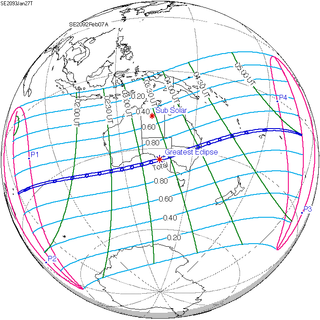
A total solar eclipse will occur at the Moon's descending node of orbit on Tuesday, January 27, 2093, with a magnitude of 1.034. A solar eclipse occurs when the Moon passes between Earth and the Sun, thereby totally or partly obscuring the image of the Sun for a viewer on Earth. A total solar eclipse occurs when the Moon's apparent diameter is larger than the Sun's, blocking all direct sunlight, turning day into darkness. Totality occurs in a narrow path across Earth's surface, with the partial solar eclipse visible over a surrounding region thousands of kilometres wide. Occurring about 1.3 days after perigee, the Moon's apparent diameter will be larger.
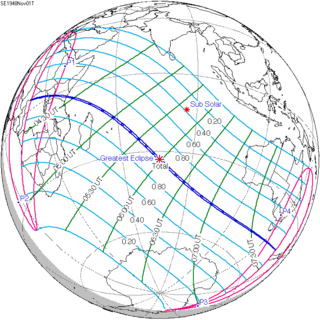
A total solar eclipse occurred at the Moon's descending node of orbit on Monday, November 1, 1948, with a magnitude of 1.0231. A solar eclipse occurs when the Moon passes between Earth and the Sun, thereby totally or partly obscuring the image of the Sun for a viewer on Earth. A total solar eclipse occurs when the Moon's apparent diameter is larger than the Sun's, blocking all direct sunlight, turning day into darkness. Totality occurs in a narrow path across Earth's surface, with the partial solar eclipse visible over a surrounding region thousands of kilometres wide. Occurring about 2.4 days after perigee, the Moon's apparent diameter was larger.

A total solar eclipse occurred at the Moon's descending node of orbit between Tuesday, October 21 and Wednesday, October 22, 1930, with a magnitude of 1.023. A solar eclipse occurs when the Moon passes between Earth and the Sun, thereby totally or partly obscuring the image of the Sun for a viewer on Earth. A total solar eclipse occurs when the Moon's apparent diameter is larger than the Sun's, blocking all direct sunlight, turning day into darkness. Totality occurs in a narrow path across Earth's surface, with the partial solar eclipse visible over a surrounding region thousands of kilometres wide. Occurring about 2.6 days after perigee, the Moon's apparent diameter was larger.

A total solar eclipse will occur at the Moon's descending node of orbit on Saturday, September 4, 2100, with a magnitude of 1.0402. A solar eclipse occurs when the Moon passes between Earth and the Sun, thereby totally or partly obscuring the image of the Sun for a viewer on Earth. A total solar eclipse occurs when the Moon's apparent diameter is larger than the Sun's, blocking all direct sunlight, turning day into darkness. Totality occurs in a narrow path across Earth's surface, with the partial solar eclipse visible over a surrounding region thousands of kilometres wide. Occurring about 2.5 days before perigee, the Moon's apparent diameter will be larger. This will be the last solar eclipse of the 21st century.
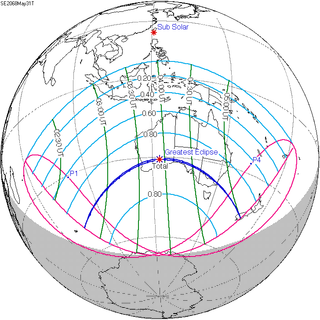
A total solar eclipse will occur at the Moon's descending node of orbit on Thursday, May 31, 2068, with a magnitude of 1.011. A solar eclipse occurs when the Moon passes between Earth and the Sun, thereby totally or partly obscuring the image of the Sun for a viewer on Earth. A total solar eclipse occurs when the Moon's apparent diameter is larger than the Sun's, blocking all direct sunlight, turning day into darkness. Totality occurs in a narrow path across Earth's surface, with the partial solar eclipse visible over a surrounding region thousands of kilometres wide. Occurring about 4.7 days after perigee, the Moon's apparent diameter will be larger.
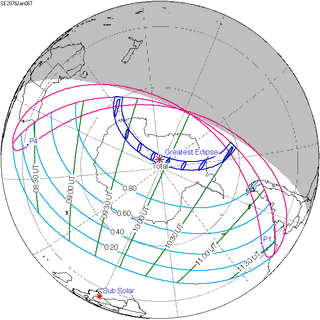
A total solar eclipse will occur at the Moon's descending node of orbit on Monday, January 6, 2076, with a magnitude of 1.0342. A solar eclipse occurs when the Moon passes between Earth and the Sun, thereby totally or partly obscuring the image of the Sun for a viewer on Earth. A total solar eclipse occurs when the Moon's apparent diameter is larger than the Sun's, blocking all direct sunlight, turning day into darkness. Totality occurs in a narrow path across Earth's surface, with the partial solar eclipse visible over a surrounding region thousands of kilometres wide. Occurring about 8.5 hours before perigee, the Moon's apparent diameter will be larger.

A total solar eclipse will occur at the Moon's descending node of orbit between Sunday, August 23 and Monday, August 24, 2082, with a magnitude of 1.0452. A solar eclipse occurs when the Moon passes between Earth and the Sun, thereby totally or partly obscuring the image of the Sun for a viewer on Earth. A total solar eclipse occurs when the Moon's apparent diameter is larger than the Sun's, blocking all direct sunlight, turning day into darkness. Totality occurs in a narrow path across Earth's surface, with the partial solar eclipse visible over a surrounding region thousands of kilometres wide. Occurring about 2.3 days before perigee, the Moon's apparent diameter will be larger.
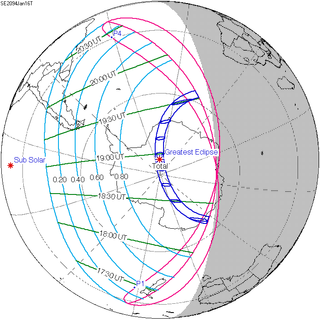
A total solar eclipse will occur at the Moon's descending node of orbit on Saturday, January 16, 2094, with a magnitude of 1.0342. A solar eclipse occurs when the Moon passes between Earth and the Sun, thereby totally or partly obscuring the image of the Sun for a viewer on Earth. A total solar eclipse occurs when the Moon's apparent diameter is larger than the Sun's, blocking all direct sunlight, turning day into darkness. Totality occurs in a narrow path across Earth's surface, with the partial solar eclipse visible over a surrounding region thousands of kilometres wide. Occurring about 10.5 hours before perigee, the Moon's apparent diameter will be larger.
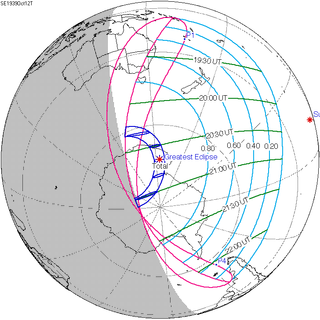
A total solar eclipse occurred at the Moon's ascending node of orbit on Thursday, October 12, 1939, with a magnitude of 1.0266. A solar eclipse occurs when the Moon passes between Earth and the Sun, thereby totally or partly obscuring the image of the Sun for a viewer on Earth. A total solar eclipse occurs when the Moon's apparent diameter is larger than the Sun's, blocking all direct sunlight, turning day into darkness. Totality occurs in a narrow path across Earth's surface, with the partial solar eclipse visible over a surrounding region thousands of kilometres wide. Occurring about 1.8 days after perigee, the Moon's apparent diameter was larger.
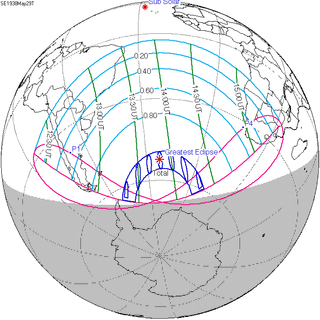
A total solar eclipse occurred at the Moon's descending node of orbit on Sunday, May 29, 1938, with a magnitude of 1.0552. A solar eclipse occurs when the Moon passes between Earth and the Sun, thereby totally or partly obscuring the image of the Sun for a viewer on Earth. A total solar eclipse occurs when the Moon's apparent diameter is larger than the Sun's, blocking all direct sunlight, turning day into darkness. Totality occurs in a narrow path across Earth's surface, with the partial solar eclipse visible over a surrounding region thousands of kilometres wide. Occurring about 1.2 days before perigee, the Moon's apparent diameter was larger.

A total solar eclipse occurred at the Moon's ascending node of orbit on Saturday, October 1, 1921, with a magnitude of 1.0293. A solar eclipse occurs when the Moon passes between Earth and the Sun, thereby totally or partly obscuring the image of the Sun for a viewer on Earth. A total solar eclipse occurs when the Moon's apparent diameter is larger than the Sun's, blocking all direct sunlight, turning day into darkness. Totality occurs in a narrow path across Earth's surface, with the partial solar eclipse visible over a surrounding region thousands of kilometres wide. Occurring about 1.9 days after perigee, the Moon's apparent diameter was larger.


























































































































